

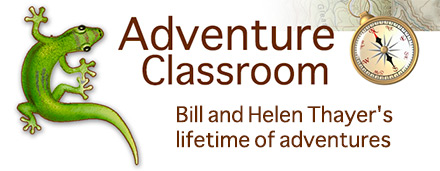
WALKING THE GOBI JOURNAL
We were flown to the far western edge of the desert to where two bactrian camels waited for us. These two humped camels are indigenous to Mongolia. Our plan is to walk all the way across the entire length of the Mongolian Gobi Desert, west to east, leading two camels loaded with gear, food and water. We will be a two person team with no others accompanying us as we walk across the desert. Three resupplies will be flown in as a safety factor against the fact that the Gobi is a dry, parched place with uncertain water supplies. In our flight over the western part of the Gobi we saw a desert already showing signs of dryness and solitude as nomad families have already begun to move herds across the desert to find water. This is why we decided on three resupplies instead of two.
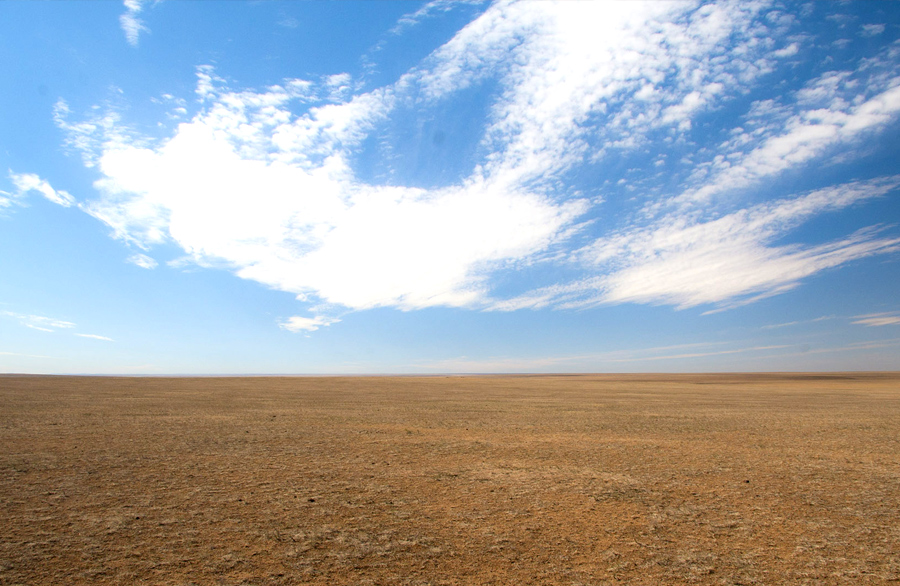
The wells aren't marked on any maps and are difficult to find at best. Even if we find any they most likely will be dry. We will be communicating with the outside world by the old fashioned method of sending messages out with desert nomads on camels and horses. They will ride north to small towns on the northern edge of the desert and pass the messages onto others who will then take our messages to the capital. Our resupply plane will take out a message with each of the three resupplies. Nomads will be moving about the desert as they look for food and water. Those going in a northerly direction will carry our messages. Not high tech but workable and somehow very satisfying to be able to still use old ways that are more in keeping with the ancient lifestyle these people live.
. . . . . . . . . . . . . . . . . . . . . . . . . . . . . . . . . . . . . . . . . . .
On day two we discovered the full fury of a Gobi Desert storm that engulfed us in a black wall of sand driven by winds that we guessed to be 80 mile-per-hour. Small rocks hit our bodies like shrapnel. The choking sand and dust blotted out the sky and reduced our world to a few feet. We shoved on close-fitting goggles and bandanna masks as fast as our fingers could move, but our eyes were already watering from the blasts of sharp grit. Screaming wind slammed into us. Lightening struck the earth, and thunder cracked close behind. The camels were already crouched on the ground. We dove behind their humps just as the first wind-driven drops pelted us, stinging our backs with their force. We held onto their tie-down ropes to avoid being blown away. The camels, our life-saving anchors, were as still as stone, with heads close to the ground to screen out the blinding fury. Jagged streaks of lightening flashed so close we smelled the odor of burned air and earth. After three hours the storm passed by. It was too late in the day to travel so we camped and began the process of digging our gear out from below a thick layer of sand For the first days we've only seen a desert that stretches ahead of us in great rolling plains. Because this is still spring they are covered in a gray-green shroud of tiny plants no more than three inches high. The Altay Mountains form a high rocky barrier to the north with the highest peaks over 12,000 feet still wearing their snowy caps. To the south lies a barrier of lower mountains that guard the Chinese border. Ahead, individual mountains rise up from the desert plains like ships at sea. The afternoon temperatures hover around 90 degrees F.
. . . . . . . . . . . . . . . . . . . . . . . . . . . . . . . . . . . . . . . . . . .
After breaking into a daily routine our plan is to travel as fast as possible to cover as much distance as we can before the July temperatures hit us. We are traveling in summer because the Gobi Desert experiences temperatures of minus 40 F. degrees and cold Siberian winds during the long polar winters. Occasionally we see gazelles race away kicking up dust while small gray lizards scurry out of our path.

A few wild donkeys raised their heads for a startled look at us before whirling away to the south. We marvel at these animals and their ability to live in such a dry inhospitable place. The Gobi is not a desert of sand dunes such as we trekked cross in the Sahara, especially in the western Gobi. We will cross no rivers and oasis will be rare. There should be an occasional well, often dry, but the wells are not marked on maps. The Gobi is a desperately dry place and the people and their herds who live here are true survivors. At this point we dare not think too much about all the hot miles and sand storms that lay ahead of us. We have been traveling through scrub desert. Dry and sometimes thorny bushes no more than two feet high cover this section. They are obviously plants that don't require much water.
. . . . . . . . . . . . . . . . . . . . . . . . . . . . . . . . . . . . . . . . . . .
Yesterday we crossed what seemed like an endless plain that stretch to the horizon. Sometimes dust devils, (miniature tornadoes), whirl toward us, at times engulfing us in their swirling sand and dust as they hiss their way past. We even trekked through a deep canyon system, a waterless, wretched place, with high rocky mountains several hundred feet high of red and brown sheer rock. We named the canyons "the canyons of death" after passing the bodies of 36 dead goats, sheep, cattle and camels which had obviously died the terrible lingering death of thirst. We are constantly amazed by the ability of desert animals to survive, especially the herd animals who appear to sometimes have nothing but dirt to eat. It is the end of a long hard winter in which many herd animals died. The survivors are thin and are depending on a good summer to stay alive through the coming winter.
. . . . . . . . . . . . . . . . . . . . . . . . . . . . . . . . . . . . . . . . . . .
Today we head across the Southern Altai Gobi Nature Reserve. What we see is a place no different to the rest of the desert. There are no barriers, no fences, just a continuation of the same dry, burnt plains. The only reason we know it is a Reserve is because it shows on our maps. There are no signs or boundries -- and no trees anywhere -- a shady tree is but a dream. Yesterday, Just outside the Reserve we erected our tent alongside a ger. We were treated to Nomad hospitality. We were fed salty tea laced liberally with goat milk. There was an endless supply of fatty goodies. Then just in time to save our stomachs from further insult we were given a bowl of traditional Mongolian soup which we ate with real delight. Surely there is not a race of people more kind and hospitable than the Gobi Desert Nomads. These people survive searing heat, wicked sand storms and an extreme lack of water. In winter they survive minus 40 F. degree temperatures. The Gobi doesn't willingly tolerate humans. Until yesterday's encounter we had not seen people for several days.
. . . . . . . . . . . . . . . . . . . . . . . . . . . . . . . . . . . . . . . . . . .
The shimmering heat rose to 113 degrees. Ahead lay a short sandy area where the sun reflected back to us in skin-scorching waves even though we traveled with shirt sleeves pulled down to protect our skin. A camel and three goats lay dead alongside a salt-encrusted bog where the poor animals had probably tried to drink in desperation.Even a minor mistake in such a land can bring the torture of a lingering death from thirst. On day 24 searing winds blew throughout the morning. By afternoon rising dust clouds had transformed the sun into a fiery red disk that was barely visible behind a screen of brown dust. Suddenly we saw ahead the sight of a welcome refuge; the white shape of a ger with a horse tied to a rail outside. We hitched our camels along side the horse and, observing the Mongolian custom of never knocking on a door, opened it and walked in. We were the first foreigners this family had ever met and became somewhat of a curiosity. Our hostess immediately added dried dung to the fire to heat water for tea. Dung, when dried, burns hot and odorless.
. . . . . . . . . . . . . . . . . . . . . . . . . . . . . . . . . . . . . . . . . . .
We have left the Southern Altai Gobi Nature Reserve, although we are not sure exactly when we did. We are in the southern-most part of the Gobi and very close to China. We are crossing shimmering black gravel plains that seem to stretch to eternity -- everything here goes on forever.
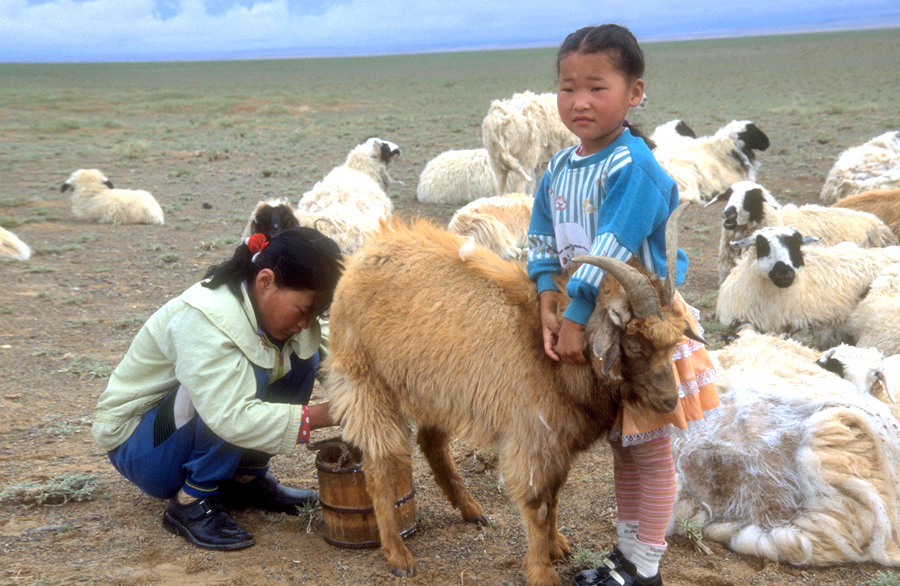
The heat rises off the plains in scorching waves. Sometimes our eyes grow weary of the same landscape and our bodies rebel against the constant need to keep going. We keep our sleeves rolled down to keep the burning sun off our skins. We have been pushing hard, averaging 33 miles per day to avoid the July heat that we know will be over 120 degrees. In July we will have to stop during the middle hours so that we can put up our shade and try to survive the heat. For the next few days we will be traveling through an area of no human habitation and no water. At this point even a single tree would be a welcome sight. Many people want to know what we eat on these long treks. Here is our basic diet: Breakfast..oatmeal, dried fruit, milk powder, hot chocolate Day snacks...crackers, dried fruit, cookies, cold chocolate drink, Dinner...rice, instant potatoes, dried meat bits, soup, cookies, hot chocolate, dried fruit. Dried fruit is dates, apricots, bananas, apples, pineapple. Supplements...Vitamin C, multi vitamin-mineral supplement, calcium The camels survive by brousing desert vegetation. We give them one cookie each in the morning and at night as a reward.
. . . . . . . . . . . . . . . . . . . . . . . . . . . . . . . . . . . . . . . . . . .
We didn’t realize the full extent of what lay ahead of us and how life threatening it would be; a long period of unimaginable thirst. Finally emerging from the quagmire of weariness that only extreme thirst can produce we at last found water—life saving water. Later we saw a cluster of buildings in the distance not shown on our maps. Soon we entered an abysmally poor village and were astonished by the quantity of multihued glass from broken vodka bottles that lay scattered across the entire sandy area of the village. A few listless people stood watching us and after asking us where we were from they told us that we were the first non-Mongolians they had seen. Except for a few barely producing family gold mines in the surrounding rocky mountains there appeared to be no available work. After visiting the well to water the camels and top-off our water containers we forged ahead to make up for the time we had lost over the last week.
. . . . . . . . . . . . . . . . . . . . . . . . . . . . . . . . . . . . . . . . . . .
Today we arrived at Dalanzadgad, a dull, dry, dusty town with a few bored dogs wandering about the sparse streets. This is where tourists fly to and travel to a nearby national park and briefly experience a very tiny piece of the Gobi. For the last few days we've traveled a more northerly course. This put in nomad territory and we have met and stayed with several nomad families who welcomed us into their gers. They always serve tea with lots of milk and salt added. The food is often hard curds made from goat or camel milk. We were also given yogurt made from these animals milk. Some of the yogurt tasted good to our western taste buds. Camel milk is thicker and sourer than cows milk. Mares milk is so acidic that it has a tremendous impact on our stomachs as we try to be polite and drink a reasonable bowl of it. The nomads eat an extremely high fat diet but we are gradually adjusting to the new foods.
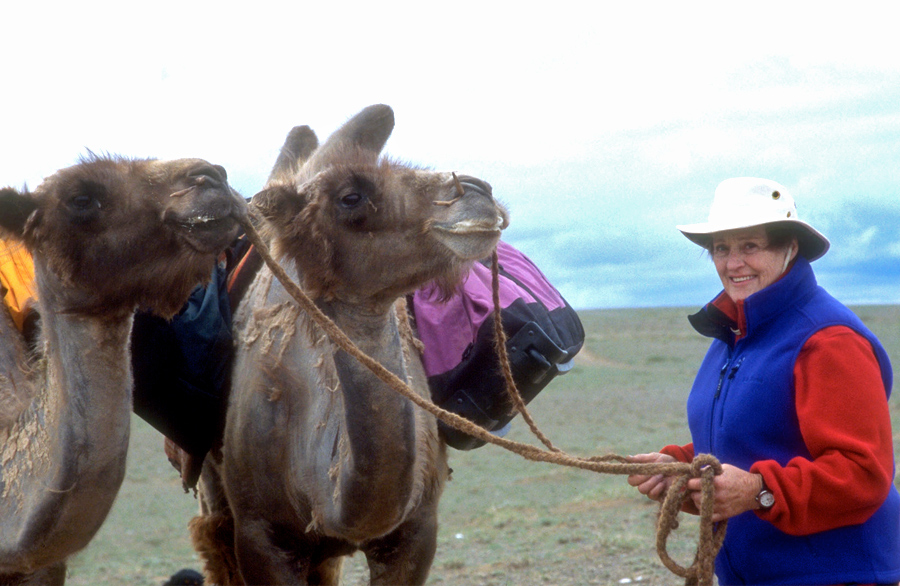
These people are very kind and gentle. They treat their animals with great respect. They are not a cruel or excitable race of people. We continually marvel at the way they survive this hot, terribly dry, most difficult of deserts. We have been privileged to learn and share these people's lifestyle and customs that they have lived by for centuries just as their ancestors did. To trek across this desert is a test of our endurance and determination, but it is also an opportunity to learn desert ways. A hot wind sends miniature tornadoes of sand and dust that hiss and swirl around us if we are caught in their path. Sometimes one will approach us directly along our path only to turn aside at the last minute. They twist and turn as if alive, picking up sand and rocks to finally disappear over the horizon. The man at the last ger told us these dust devils are spirits of the desert that try to lead unwary travelers astray. We only experience them on hot, still days. The blowing dust is a trial to our throats. We have to wear our masks and goggles much of the time. Sometimes the hot wind that not only brings heat but fine dust with it is very tiresome and adds to our fatigue burden each day. We are still traveling for at least 15 hours a day. The temperature is rising steadily with the season. We now see 100 degrees by noon. When we stop at night it's wonderful to take our hot boots off and rest weary bodies. Our eyes are suffering greatly from a steady barrage of sand and dust.
. . . . . . . . . . . . . . . . . . . . . . . . . . . . . . . . . . . . . . . . . . .
From Dalanzadgad we traveled north to see the "Vultures Mouth," a gorge with almost permanent snow trapped in a narrow gorge in the mountains. It's a place of quite heavy snowfall in the winter and where no sun in the summer reaches down into the deep gorge. Therefore the snow accumulates in this sunless place with little melting. Although explainable, it is still odd to see this patch of snow here in the Gobi. Apparently there is some concern since most of the snow has melted during the last few summers, leading experts to wonder about global warming. From this natural gorge we traveled still farther north to the "Flaming Cliffs" where the first dinosaur eggs were discovered by Roy Chapman Andrews in the early 1920s. The correct name of the area is Bayanzag, but the western tourist industry calls it "Flaming Cliffs" because of the red mounds and cliffs where many dinosaur finds have occurred. It is a truly spectacular place of rich color and history.
. . . . . . . . . . . . . . . . . . . . . . . . . . . . . . . . . . . . . . . . . . .
fter our sight-seeing side-trip is over we are glad to once more be on our way east across the Gobi. We're traveling through this giant oven with no 'off' switch. The temperatures have risen to 110 to 115 degrees F. for the last couple of days. I'm writing this journal entry in a ger where they allowed us to stay for a few hours to escape the heat. Even the family herd-guard dogs are seeking the sparse shade provided on the shady side of the ger. The animal feed and water has dried up here, so tomorrow this family will load their camels and head many miles north to find another source of feed and water. Last night we helped another family herd their camels and goats and later we helped milk them. They are also moving today and will take with them cashmere and wool they have shorn from their animals to a small town in the north. Here they will sell this raw wool to a buyer who will then truck it to the capital for processing.
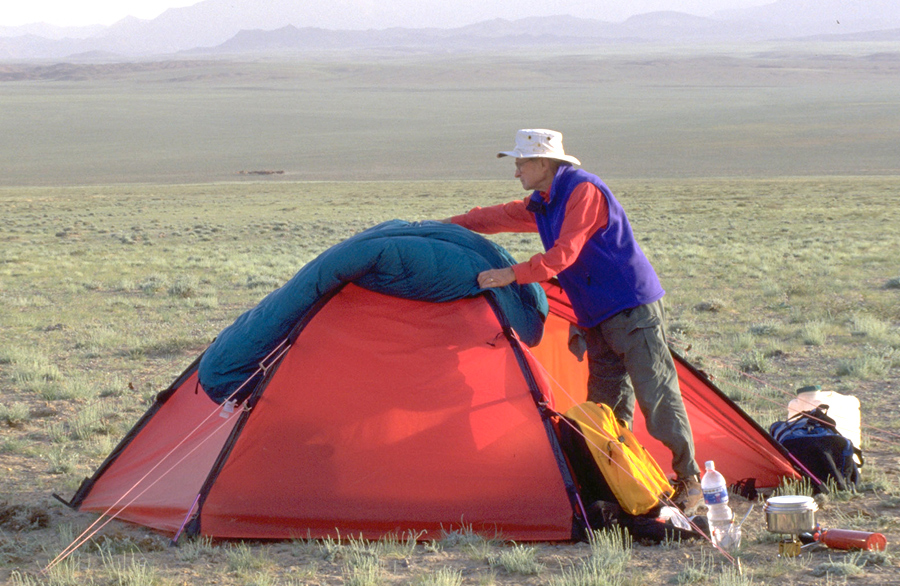
We are sitting in the ger with a nomad family. The evening herding has just been completed, which means that we are about to be served a bowl of mares milk -- a real test of survival for our western stomachs. It is so sour, much like a lemon. Just now a spinach salad would look wonderful. But there is no spinach in Mongolia.
. . . . . . . . . . . . . . . . . . . . . . . . . . . . . . . . . . . . . . . . . . .
Today we are traveling south east across slightly rolling plains with a scale that defies the imagination. As we look ahead we can only see miles of seemingly nothing and days and days of hard work ahead. The heat is over 115 degrees and is taking a toll on our bodies. We have to drink more to ease the dryness in our throats. We are also increasing our dose of daily salt tablets. We treat our eyes daily now with a soothing lotion. The grit in our eyes is hard to bear by noon in this sandblasted corner of an empty world. At night when at last we can stop our bodies are beyond mere weariness. We dare not take a rest day because every day of delay is just another day of tormenting heat. When we stop for the evening and there is no ger in sight, we realize how
. . . . . . . . . . . . . . . . . . . . . . . . . . . . . . . . . . . . . . . . . . .
We have been traveling south east toward the Chinese border and now we will turn east and slightly north to stay well north of the border. We have entered an area where there is more sand. Sometimes footing is soft, making walking difficult. In these conditions one can be excused for a growing dislike of sand. We are definitely not going to stop to build sand castles along the way. The camels with their padded feet do well in these conditions. Their feet don't sink down as ours do. Sometimes they grunt or let out an ear splitting bellow over some imagined discomfort. I say imagined because when we inspect them for displaced loads or other problems there is usually no problem at all. But their bellows do succeed in getting our attention. A cookie seems to make everything right again. Occasionally we see clumps of grass surrounding a small pool of water—a small oasis in this parched landscape. Most of these water holes are too saline for us although Tom and Jerry can tolerate the salt. We do have a small desalinization filter with us for emergencies.
. . . . . . . . . . . . . . . . . . . . . . . . . . . . . . . . . . . . . . . . . . .
Over 1,000 miles at last. Now we really feel as though we are going home soon to escape this awful draining heat and dryness. Temps have been around 120 to 125 degrees F. in the shade. We are forced to create our own shade by erecting 4 poles and a tarpaulin. We ran into a lot of nasty scorpions who make very bad traveling companions. The trick is to keep them out of the tent. Two hours of another major sand storm kept us pinned down. The two camels who faithfully walk behind us on long leads suddenly became very agitated and started moaning then bellowing. Half an hour later we saw a vast, darkly ominous cloud stretching from the earth to the sky racing toward us. There was no time to put the tent up. We kushed the two camels with their backs to the storm, cinched down the loads tight then crouched down on the sandy earth pressing hard against the camels for protection. The blowing sand blasted us, but our goggles and masks kept the stuff out of our eyes, noses and mouths. Small rocks flew around us at times and at the height of the storm the wind whistled and roared. Day became night until at last the sand storm passed, the sun reappeared in full force and all was calm again except for a 10 mile per hour hot wind that continued to blow across the desert until dusk.

We met two families at their gers today. They fed us a delicacy of partly dried mutton. It tasted half rotten and really made our eyes cross. To be comfortable with the food a person definitely needs to become accustomed to it over a long period of time. The people of the Gobi are some of the most healthy people we have ever met. Their lifestyle, in spite of a lack of water, is very clean; they are healthy, bright eyed and smiling. It has been an remarkable opportunity to share their lifestyle.
. . . . . . . . . . . . . . . . . . . . . . . . . . . . . . . . . . . . . . . . . . .
We haven't seen people or their gers for several days. Everyone has left to find feed for the animals and water. We are alone out here as we have been many times. It's brutally dry and hot all around us. The temp went up to 126° F again. It's difficult to keep going at times and we can't make any mistakes out here in this is tough, unforgiving desert. As the summer temps rise and the sun unflinchingly beats down on us we are reminded of the vulnerability of the human body in these hostile conditions. After we had the accident with the water, when one camel rolled and split a lot of bottles, we were on half rations for 7 days until our next resupply arrived. We were getting desperate. To be low on water in this place is frightening. The thought of dying out here all by ourselves of thirst is not a pretty thought. We had to resort to using our desalinization unit which saved the day for us until our resupply arrived. We found an almost dry water-hole and were able to turn filthy, salt water into drinkable water. We are glad we added the unit to our survival gear. We are now north of a small, abysmally poor, sandy town and traveling east into a hot head wind. The camels plod on with a natural dignity while we, uncomfortably hot and sweating, sometimes stumble over a rock or a soft sandy area. Toward evening, when we are so tired, we look with envy at the camels who never seem to notice the sometimes unbearably long, sand blasted, hot miles.
. . . . . . . . . . . . . . . . . . . . . . . . . . . . . . . . . . . . . . . . . . .
Once again we're close to the Chinese border and heading north east to put more distance between us and the border. We are in a flat, dry, waterless area. We think of going home soon. Home exists just beyond the edge of our imagination. We dream of seeing a tree, even a small one would do at this stage. We haven't seen a tree since we started. We are on our second pair of boots each. The rocks, gravel and sand are very abrasive. We have had to be careful of our tent zippers. Our Hilleberg tent has been amazing. It has taken the heat, sand and high winds without a problem. It's unbearably hot with a hot breeze which sometimes increases to around 10 to 15 miles per hour. Our clothes are salty and dusty. We press onward, eastwards, into the unrelenting shimmering heat waves.
. . . . . . . . . . . . . . . . . . . . . . . . . . . . . . . . . . . . . . . . . . .
Today our thermometer hit 126° F. We have recovered from our 7 days of thirst and our parched throats now feel as though they belong on our bodies. We stayed with a friendly group of nomads last night and drank mares milk, ate some very good yogurt and goat curds. By now we are used to the various foods, but the mares milk is still a test of our stomachs and resolve. We are close to the end of our journey and looking forward to ending this endurance test. We have surrendered ourselves to this desert environment in order to survive the heat, sandstorms and at times the clinging sand of the dunes. At days end our bodies are heavy with fatigue and glad to lay down to rest. In spite of all the inhumane deprivation, the long, sometimes lonely days and grinding weariness of this long journey, we will miss our nomad friends who have welcomed us like family. We can't say enough good things about these people. The happiest, healthiest, most beautiful indigenous people we have ever met. They are clean with bright smiles and even though many had lost large numbers of animals during the zuds of the last two winters they were optimistic, and happy. We learnt a lot from them.
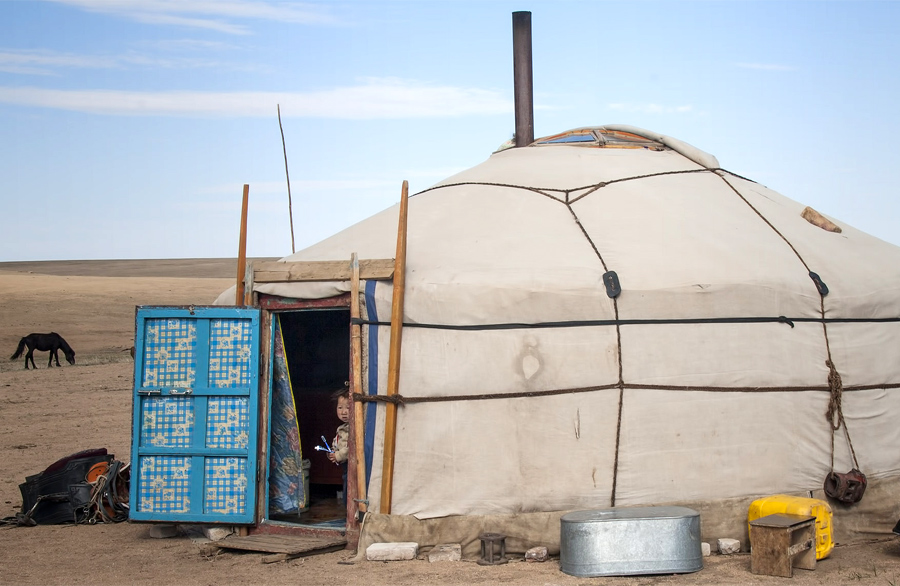
Our camels carried our loads day after day sometimes with considerable bellowing and general protest. But they always plodded along at a good pace. We are very pleased to know that they will be well cared for the rest of their lives. We should say a few words about our sponsor's wonderful products—Thorlo soxs and Hilleberg tents. Both were amazingly durable. Our feet were always in good shape thanks to our Thorlo's and the Hilleberg tent took an enormous beating in the sand storms and high winds. Thanks to the Thorlo and Hilleberg people for their support and products. We will continue to use these products in future expeditions.
. . . . . . . . . . . . . . . . . . . . . . . . . . . . . . . . . . . . . . . . . . .
As we took our first steps seventy days ago it was difficult to comprehend all the miles and difficulties we would face. Lately we have seen more gazelle and even a few wild donkeys called khulan. The khulan stop to check us out then race away. The gazelle disappear with long leaping bounds on stick thin legs. Blazing speed is their best defense against wolves that roam the desert. We have seen several wolves at various times throughout our trek. They are no danger to us but we have to be careful at night when they might attack our camels. There have been at least two occasions when wolves have circled us trying to get at the camels and we have had to fend them off. The nomads keep dogs to guard their herds of sheep, goats, and camels, but even then a wolf will sometimes steal an animal. Today there were more mirages of lakes and even trees that teased our sun baked minds. By day we struggle on one step at a time, our bodies gradually losing the battle against fatigue and dehydration. Our highest temperature has been 126 degrees in the shade. The lower nighttime temperatures give us welcome relief. The intense heat that accumulates in a hot desert such as the Gobi escapes at night due to the extremely low humidity. Only about 10% is deflected back to the earth by dust particles. The heat that stays over 120 degrees most of the time saps our strength by noon. We have little appetite for food that is now liberally laced with sand. The persistent heat destroys our appetites. All we crave now is water. We carry our day’s water in one-quart bottles for easy access and tie them on the shady side of the camels. By noon the water is almost too hot to drink. We’re consuming one and a half gallons each per day and still losing ground to dehydration. The Chinese border is very close. As we look south across the sparsely marked border we see an endless desolation that is a continuation of the terrain we are walking through. The two camels are doing well. We included grain in our resupply to make sure they have enough to eat. The desert is so dry from the burning sun and hot wind that we cross long stretches where there is little forage. They have become docile pets and enjoy their cookie treats each day.
. . . . . . . . . . . . . . . . . . . . . . . . . . . . . . . . . . . . . . . . . . .
Today we can see the end of the desert and the beginning of the eastern grasslands -- beautiful green grasslands that stretch as far as the eye can see -- no more desert. We have walked across the Gobi for its entire length. Time to go home away from the wind, sand and heat. Our camel owners who were notified by our resupply people were here to meet us and very proudly gathered the two camels for the return journey to their home. They will be well cared for the rest of their lives which is very important to us. It was very difficult to say good-bye to them. These two camels were an important part of the crossing and their owners are very proud that they own two such camels and we are very grateful for their help. We will return to Mongolia in the future to visit Tom and Jerry and their owners. Physically it has been a tough journey at times. The heat rising off a desperately dry desert becomes oppressive and unending. Shade became but a distant memory. The dark gray-black gravel plains were hot and seemed to go on forever. We would look ahead to the horizon that had no visual relief except for the many mirages. At least the mirage lakes looked cool even though we knew they didn't exist. My car accident injuries sometimes made walking an adventure in itself. I used one trekking pole, then two. I had to gear up and discipline myself to always remember the goal and minimize any painful periods of walking. Mentally it is hard to keep an optimistic frame of mind day after day especially when the temps go over 110 degrees F. In the beginning we dared not think of all the miles ahead of us. We mentally broke the journey up into sections and finished one section at a time. When we passed the 1,000 mile goal we could allow ourselves to think of going home. The dryness and loneliness of the desert made us realize how vulnerable we were. Especially when the camel rolled and broke our water bottles. Heat and thirst don't make good companions. I write this as we fly north out of the desert in our resupply plane. We leave with a certain amount of sadness. It was a difficult journey and at times we had to push extremely hard through the blowing sand and the depressing heat. But it seems, as with our past expeditions, when the struggle is almost unbearable it makes victory all the more precious. As the desert disappears behind us we know that a part of us will always remain there and the Gobi and its resilient, wonderful people will always keep a small part of our hearts. It has been a privilege to know them.
Back to Journals Index
